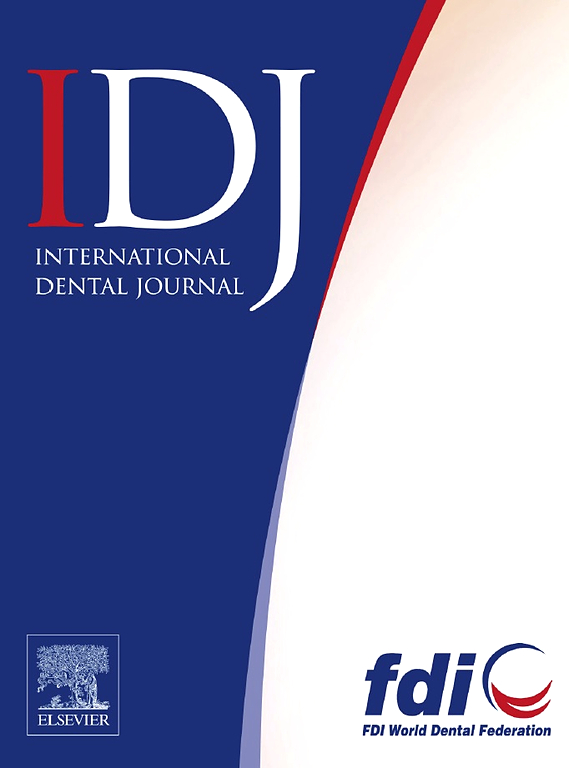不同通用粘合剂在人类牙本质上的微拉伸粘合强度和破坏模式
IF 3.2
3区 医学
Q1 DENTISTRY, ORAL SURGERY & MEDICINE
引用次数: 0
摘要
目的:本研究旨在比较 4 种不同通用粘接剂系统(UAs)在人类牙本质上的微张力粘接强度(µTBS)和失效模式:研究对 32 颗人类第三磨牙的咬合面进行切片,并根据所使用的粘接剂系统将其分为 4 组。A 组A 组:Palfique 通用粘接剂;B 组:单粘接通用型;C 组:全粘接通用型;D 组:单粘接通用型:全粘接通用型,以及 D 组:单涂层 7 通用型。测试前,试样要经过 10,000 周期的热循环老化过程(n = 32)。然后,每组取 8 个梁,使用数字万能试验机以 1 毫米/分钟的速度进行 µTBS 测试。微拉伸粘接强度值以兆帕斯卡(MPa)为单位进行分析,并使用体视显微镜对破坏模式进行评估。韦尔奇参数方差分析与稳健方差分析和 Games-Howell 事后检验用于 µTBS 比较,费雪精确检验用于确定粘合剂类型与失效模式之间的关联。显著性水平设定为 P < .05:结果:D 组的 µTBS 明显高于 A 组 (P < .001) 和 B 组 (P<.001),但与 C 组相比无明显差异 (P=.075)。此外,B 组和 C 组的 µTBS 明显高于 A 组(P < .001 和 P < .001),但 B 组和 C 组之间没有明显差异(P = .132)。此外,A 组与粘合失效模式显著相关(P < .05),而 B、C 和 D 组与混合失效模式显著相关(P < .05):One Coat 7 通用粘接剂系统与 Palfique 通用粘接剂和 Single Bond 通用粘接剂相比,显示出更高的微拉伸粘接强度值以及与牙本质更高的化学作用。然而,与 All-Bond Universal 相比,没有观察到明显的差异。本文章由计算机程序翻译,如有差异,请以英文原文为准。
Microtensile Bond Strength and Failure Mode of Different Universal Adhesives on Human Dentin
Aim
The aim of this study was to compare the microtensile bond strength (µTBS) and failure mode of 4 different universal adhesive systems (UAs) on human dentin.
Materials and methods
The study sectioned the occlusal thirds of 32 human third molars and divided them into 4 groups based on the adhesive system used. Group A: Palfique Universal Bond, Group B: Single Bond Universal, Group C: All-Bond Universal, and Group D: One Coat 7 Universal. The specimens underwent a 10,000-cycle thermocycling ageing process prior to testing (n = 32). Afterwards, 8 beams were obtained per group and subjected to µTBS testing using a digital universal testing machine at a speed of 1 mm/min. The microtensile bond strength values were analysed in Megapascals (MPa), and the failure mode was evaluated using a stereomicroscope. Welch's parametric ANOVA with robust variance and the Games-Howell post hoc test were used for µTBS comparisons, and Fisher's exact test was used to determine the association between adhesive type and failure mode. The significance level was set at P < .05.
Results
Group D showed a significantly higher µTBS than groups A (P < .001) and B (P < .001), but no significant difference was observed with group C (P= .075). Furthermore, groups B and C showed significantly higher µTBS than group A (P< .001 and P < .001, respectively), but there was no significant difference between groups B and C (P = .132). Additionally, group A exhibited a significant association with an adhesive failure mode (P < .05), whereas groups B, C, and D were significantly associated with a mixed failure mode (P < .05).
Conclusion
The One Coat 7 Universal adhesive system showed higher microtensile bond strength values and higher chemical interaction with dentin compared to Palfique Universal Bond and Single Bond Universal. However, no significant differences were observed compared to All-Bond Universal.
求助全文
通过发布文献求助,成功后即可免费获取论文全文。
去求助
来源期刊

International dental journal
医学-牙科与口腔外科
CiteScore
4.80
自引率
6.10%
发文量
159
审稿时长
63 days
期刊介绍:
The International Dental Journal features peer-reviewed, scientific articles relevant to international oral health issues, as well as practical, informative articles aimed at clinicians.
 求助内容:
求助内容: 应助结果提醒方式:
应助结果提醒方式:


